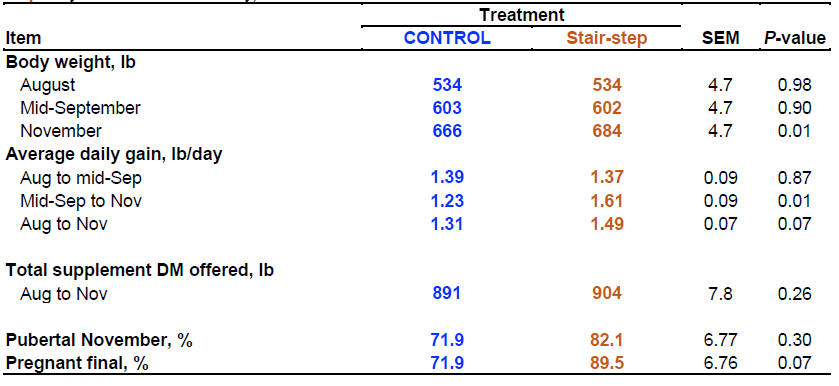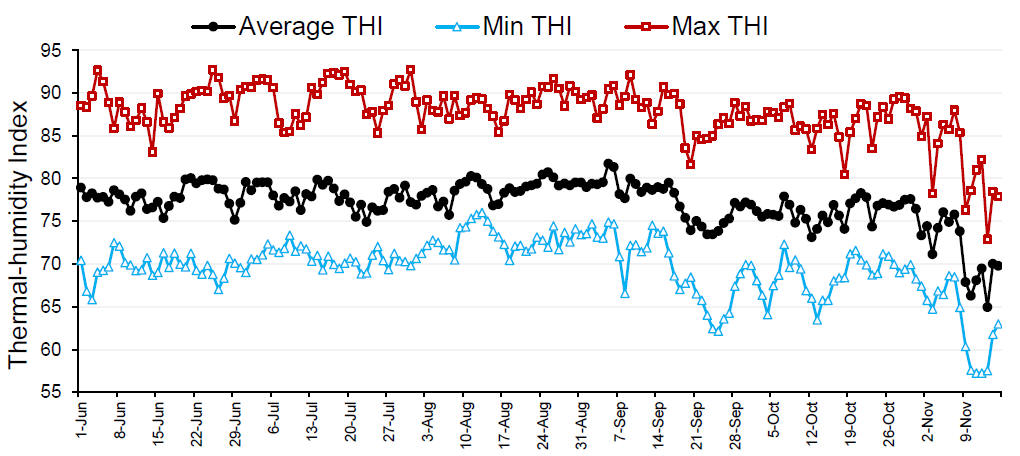- Return to Article Of The Month index
Boosting reproduction without increasing feed costs of beef heifers in Florida
February , 2021
Dr. Philipe Moriel, UF/IFAS Range Cattle Research & Education Center
Approximately 45% of U.S. beef cows are located in southern and southeastern states where Bos indicus-influenced cattle and extreme heat conditions predominate. A major limiting factor for reproductive success of Bos indicus-influenced beef heifers is the late attainment of puberty due to genetics, environment (i.e. heat stress), and nutrition. Heat stress is detrimental to cattle metabolism, growth, reproduction, health, and welfare and may become a greater challenge in the future due to the potential impact of global climate change. Environmental conditions are considered thermoneutral when thermal-humidity index (THI) ≤ 70, mild heat stress when 70 ≤ THI < 74, heat stress when 74 ≤ THI < 77, and severe heat stress when THI ≥ 77. Figure 1 shows the average, minimum and maximum daily THI values obtained at the University of Florida/IFAS - Range Cattle Research & Education Center (Ona, FL). From June to October 2019, average THI values were within or above the threshold considered as heat stress. Also, maximum THI values often reached severe heat stress levels. These challenging conditions during summer partially explain the poorer average daily gain of heifers, despite the greater nutritional composition of forage during Summer vs. Fall.

The
cow-calf industry in Florida relies on warm-season forages as the main
source of feed for beef cattle. This forage type often does not meet the
requirements of growing heifers, even if herbage mass is not a limiting
factor.
Nutritional analysis of 637 samples of forages commonly grown in Florida
(bahiagrass, bermudagrass, stargrass, and limpograss) and reported that most
of these grasses contained between 5 to 7% crude protein (CP)
and 48 to 51% total digestible nutrients (TDN),
on the basis of dry matter (DM).
Developing heifers require diets with at least 55% TDN and 8.5% CP on a DM
basis to achieve adequate growth rates (≥ 1.0 lb/day).
Nevertheless, successful reproductive performance can still be obtained if
heifers become pubertal before the initiation of breeding season. In this
article, we will provide a summary of our on-going study to optimize growth
and reproduction of Bos indicus-influenced beef heifers in
tropical/subtropical environments.
Growth Pattern (Stair-Step Strategy)
Experimental design:
The experiment was conducted at the UF/IFAS Range Cattle REC (Ona, FL) from
September 2019 to June 2020 (Year 1) and is currently being replicated from
September 2020 to June 2021 (Year 2). In September of each year, 64 Brangus
heifers were allocated into 1 of 16 bahiagrass pastures (4 heifers/pasture).
Treatments were assigned to pastures (8 pastures/treatment) and consisted
of:
control heifers supplemented with concentrate DM at 1.50% of body weight
from September until the start of the breeding season in December (day 0 to
100 of the study; CON);
or
stair-step heifers initially offered concentrate DM at
1.05% of body weight
from September to October (day 0 to 50 of the study), and then,
concentrate DM at 1.95% of body
weight (DM basis) from October until the start of the breeding season
in December (SST; day 50 to 100 of the study).
In average, both treatments consumed concentrate DM at 1.50% of body weight
from September to December (22% CP and 73% TDN; DM basis).
Preliminary results:
As designed, total supplement DM offered to heifers from August to December
did not differ between treatments in year 1 (Table 1). In terms of
growth, average daily gain from day 0 to 50 did not differ between
treatments but was greater for SST vs. CON heifers from day 50 to 100 (Table
1), leading to greater overall average daily gain for SST vs. CON heifers.
Hence, growth performance of grazing heifers was boosted by the stair-step
strategy without increasing feed costs, and such differences in growth
performance are likely explained by the results observed for intravaginal
temperatures.
Intravaginal thermometers were inserted into heifers to determine the
internal body temperatures during September and November. In September (heat
stress period), SST heifers had significantly lower intravaginal
temperatures from 9:30 am to 6:00 pm compared to CON heifers (Figure 2),
which is likely a result of lower heat increment and partially explains the
lack of treatment effects on heifer average daily gain from day 0 to 50. In
November (no heat stress period), supplement DM amount did not affect (P
= 0.39) intravaginal temperature of heifers, which likely prevented energy
waste to cope with heat stress and allowed the greater average daily gain of
SST vs. CON heifers.
Percentage of pubertal heifers at the start of the synchronization protocol
did not differ between treatments. However, SST heifers had greater final
pregnancy rates compared to CON heifers (Table 1). We are repeating this
study for another year to confirm these results, but based on data from year
1, the Stair-Step strategy may be a great opportunity to boost growth and
reproductive performance of grazing Bos indicus-influenced beef
heifers in Florida, without increasing feed costs.
References
Lynch, J. M., G. C. Lamb, B. L. Miller, R. T. Brandt, Jr, R. C. Cochran, and J. E. Minton. 1997. Influence of timing of gain on growth and reproductive performance of beef replacement heifers. J. Anim. Sci. 75:1715–1722.
Table
1.
Growth, reproduction, and supplement intake data (Year 1 only) of control
heifers supplemented with concentrate DM at 1.50% of body weight from
September until the start of the breeding season in December (day 0 to 100
of the study;
CONTROL);
or stair-step heifers initially offered concentrate DM at
1.05% of body weight
from September to October (day 0 to 50 of the study), and then,
concentrate DM at 1.95% of body
weight (DM basis) from October until the start of the breeding season
in December (Stair-step;
day 50 to 100 of the study).


Figure 1. Daily average, minimum and maximum thermal-humidity index (THI) values observed from June to November 2019 at the Range Cattle Research and Education Center. THI = (1.8 × Temperature + 32) – [(0.55-0.0055 ´ Relative Humidity) ´ (1.8 ´ Temperature – 26)].

Figure 2.
Average intravaginal temperature (September) of control heifers supplemented
with concentrate DM at 1.50% of body weight from September until the start
of the breeding season in December (day 0 to 100 of the study;
CON);
or stair-step heifers initially offered concentrate DM at 1.05% of body
weight from September to October (day 0 to 50 of the study), and then,
concentrate DM at 1.95% of body weight (DM basis) from October until the
start of the breeding season in December (SST;
day 50 to 100 of the study).

